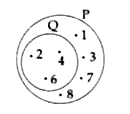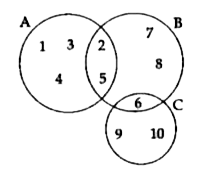In the adjoining Venn diagram , A∪B is
{2,6}
{1,2,5,6,7}
{2,3,4,6}
={1,2,3,4,5,6,7}
To solve the question regarding the Venn diagram and the operation A∪B (A union B), we can follow these steps:
1. Understand the Venn Diagram:
- A Venn diagram consists of circles that represent different sets. In this case, we have two sets, A and B, represented by two overlapping circles.
2. Identify the Universal Set:
- The rectangle surrounding the circles represents the universal set, which contains all possible elements under consideration.
3. Define A and B:
- The circle labeled A contains all the elements of set A.
- The circle labeled B contains all the elements of set B.
4. Determine A Union B:
- The operation A∪B means we are looking for all elements that are in set A, in set B, or in both.
- This includes:
- All elements that are only in A.
- All elements that are only in B.
- The elements that are common to both A and B (the intersection).
5. Visual Representation:
- In the Venn diagram, A∪B is represented by the entire area covered by both circles A and B, including the overlapping area.
- Therefore, to illustrate A∪B, you would shade or highlight the entire area of both circles.
6. Conclusion:
- The final representation of A∪B in the Venn diagram shows all elements from both sets A and B, emphasizing that the common elements are counted only once.
- A Venn diagram consists of circles that represent different sets. In this case, we have two sets, A and B, represented by two overlapping circles.
- The rectangle surrounding the circles represents the universal set, which contains all possible elements under consideration.
- The circle labeled A contains all the elements of set A.
- The circle labeled B contains all the elements of set B.
- The operation A∪B means we are looking for all elements that are in set A, in set B, or in both.
- This includes:
- All elements that are only in A.
- All elements that are only in B.
- The elements that are common to both A and B (the intersection).
- In the Venn diagram, A∪B is represented by the entire area covered by both circles A and B, including the overlapping area.
- Therefore, to illustrate A∪B, you would shade or highlight the entire area of both circles.
- The final representation of A∪B in the Venn diagram shows all elements from both sets A and B, emphasizing that the common elements are counted only once.
Similar Questions
From the adjoining Venn diagram , find the following sets :
P∪Q
View SolutionFrom the adjoining Venn diagram , find the following sets :
P∩Q
View SolutionFrom the adjoining Venn diagram , find the following sets :
Q
View SolutionFrom the adjoining Venn diagram , find the following sets :
P
View SolutionFrom the adjoining Venn diagram , find the following sets :

(i) A (ii) B (III) A∪B (iv) A∩B
View SolutionFrom the adjoining Venn , diagram , find the following sets :

(i) P (ii) Q (iii) P∪Q (iv) P∩Q
View SolutionFrom the adjoining Venn diagram , find the following sets :

(i) P
(ii) Q
(iii) P∪Q
(iv) P∩Q
View SolutionFrom the adjoining Venn diagram , write the following sets : (i) A (ii) B (iii) C (iv) A∪B (v) A∩B (vi) B∪C (vii B∩C (viii) A∪C (ix)A∩C
Also verify that :
(i) n(A)+n(B)=(A∪B)+n(A∩B)
(ii) n(B)+n(C)=n(B∪C)+n(B∩C)

View SolutionIn the adjoining diagram, AOB is a straight lines

If x+z=y, find y
View SolutionIn the adjoining diagram all the capacitors are initially uncharged, they are connected with a battery as a shown in figure. Then

View Solution
